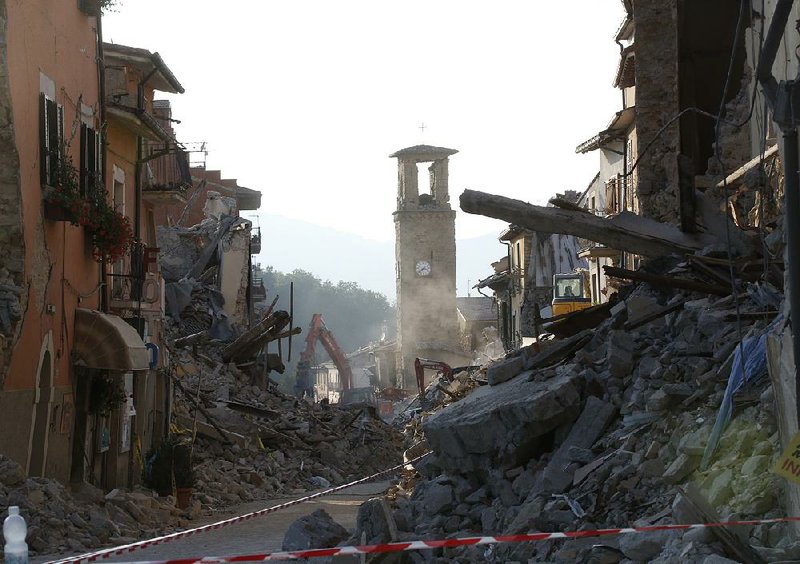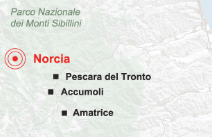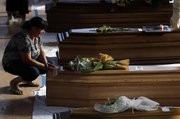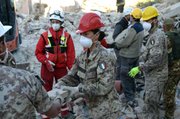AMATRICE, Italy -- Rescue workers acknowledged Friday they might not find any more survivors from Italy's earthquake as they confronted a new obstacle to their recovery work: a powerful aftershock that damaged two key access bridges to hard-hit Amatrice, threatening to isolate it.
Mayor Sergio Pirozzi, warned that if new roads weren't quickly cleared to bypass the damaged ones, Amatrice risked being cut off at a time it needs as many transport options as possible to carry emergency crews in and some of the quake's 278 victims out.
"With the aftershocks yesterday but especially this morning, the situation has worsened considerably," Pirozzi told reporters. "We have to make sure Amatrice does not become isolated, or risk further help being unable to get through."
The biggest aftershock struck at 6:28 a.m. Friday, one of the more than 1,000 that have hit the area since Wednesday's quake. The U.S. Geological Service said it had a magnitude of 4.7, while the Italian geophysics institute measured it at 4.8.
It left one key access bridge to Amatrice unusable, and damaged another one. Crews began clearing trees to create an alternate bypass road to avoid the nearly 25-mile detour up and down mountain roads that they were forced to use Friday, slowing the rescue effort.
Even before the roads were shut down, traffic into and out of Amatrice was horribly congested with emergency vehicles and dump trucks carrying tons of concrete, rocks and metal down the single-lane roads.
Multiple ambulances were also taking the dead to an airport hangar in the provincial capital of Rieti, where four big white refrigerated trucks created a makeshift morgue to which relatives came in a steady stream Friday.
Premier Matteo Renzi declared a state of emergency and authorized $56 million for immediate quake relief. The Italian government also declared today a day of national mourning and scheduled a state funeral to be attended by President Sergio Mattarella.
Thirty-four coffins were lined up in a gym in Ascoli Piceno ahead of today's Mass. A memorial service for the Amatrice victims is scheduled for next week.
The first private funeral took place in Rome on Friday for the son of a provincial police chief who was honored at one of Rome's most important basilicas. One of Pope Francis' top advisers celebrated a funeral Mass for seven other victims south of Rome.
Rescue efforts continued, but by nightfall, two full days had passed since the last person was extracted alive from the rubble.
"There is still hope to find survivors under the rubble, even in these hours," Walter Milan, a rescue worker, said Friday. But he conceded: "Certainly, it will be very unlikely."
The head of the firefighting squad, Bruno Frattasi, said there was always hope of finding someone alive. But by Friday he was talking more about time running out and recovery efforts.
"We hope to recover all the bodies," he said. "It's necessary because even if they didn't make it, they must be returned to their families."
He said the toll had stabilized in the Arquata area of eastern Le Marche region, with 49 dead and no one else unaccounted for. In Amatrice, the situation was more uncertain; Mayor Pirozzi has estimated there could still be 15 people unaccounted for.
The vast majority of the dead were found in leveled Amatrice, the medieval hilltop town famous for its bacon and tomato pasta sauce.
On Friday, Pirozzi insisted the historic center of the town would be rebuilt as it was -- not left to rubble and a "New Town" built. That was the strategy used in L'Aquila in nearby Abruzzo, where the historic center was demolished in the 2009 quake and modern housing built miles away for residents.
"I don't want -- and this is shared by everyone -- a ghetto," Pirozzi said of the widely criticized "New Town" model. "Each community must remain where it is because what is needed is a sense of belonging."
He said local and regional leaders also agreed that temporary housing for the homeless will involve prefabricated Alpine-style villas in the places where existing communities were, complete with schools, saying the important thing was to give residents hope and keep their sense of community.
"I'm convinced Amatrice will be reborn, because no night is long enough to prevent the sun from rising," he said.
Information for this article was contributed by Frances D'Emilio and Francesco Sportelli of The Associated Press.
A Section on 08/27/2016



